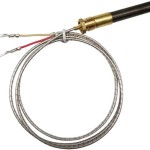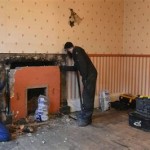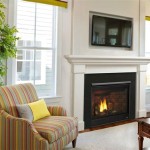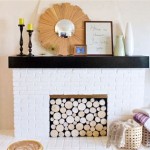Raised Fireplace Hearth: Design, Functionality, and Considerations
A raised fireplace hearth is a design element that elevates the fireplace opening above the floor level. This architectural feature offers a combination of aesthetic appeal and functional advantages. The specifics of a raised hearth, including its height, material, and style, are determined by architectural design, building codes, and the homeowner's preferences.
The primary purpose of a hearth, regardless of whether it's raised or flush with the floor, is to provide a non-combustible surface in front of the fireplace opening. This prevents sparks, embers, or hot ash from damaging the surrounding flooring, rugs, or furniture. A raised hearth enhances this protective function by providing a more substantial barrier and offering a clear visual demarcation of the fireplace area.
The installation of a raised fireplace hearth requires careful planning and adherence to building codes and safety regulations. Proper structural support is essential, especially for heavier materials like stone or concrete. The hearth must be sized appropriately for the fireplace opening and the type of fuel being burned (wood, gas, or electric). Professionals with expertise in fireplace design and construction should be consulted to ensure a safe and aesthetically pleasing outcome.
Aesthetic and Design Considerations of a Raised Hearth
The aesthetic benefits of a raised fireplace hearth are considerable. It can serve as a focal point in a room, drawing the eye and adding visual interest. The raised elevation creates a more dramatic presence, making the fireplace a more prominent feature. This effect is particularly pronounced in larger rooms or rooms with high ceilings.
The material selection for a raised hearth contributes significantly to its overall appearance. Common materials include brick, stone, tile, concrete, and wood (when permitted by code and properly constructed with non-combustible materials adjacent to the firebox). Each material offers a distinct look and feel. Brick provides a classic and rustic aesthetic, while stone can evoke a sense of natural elegance. Tile offers a wide range of colors and patterns, allowing for customization. Concrete can be molded into various shapes and finishes, providing a modern and industrial look. Wood, when used, adds warmth and texture but requires careful consideration to ensure fire safety.
The shape and size of the raised hearth also impact its visual appeal. A rectangular hearth is a common and versatile choice, while curved or custom-shaped hearths can create a more unique and contemporary look. The height of the hearth can vary depending on the desired effect. A lower hearth (e.g., 6-12 inches) provides a subtle elevation, while a higher hearth (e.g., 18 inches or more) creates a more pronounced and dramatic statement.
The style of the raised hearth should complement the overall design of the room. In a traditional setting, a brick or stone hearth with classic molding may be appropriate. In a modern setting, a sleek concrete hearth with clean lines may be more suitable. The choice of materials, shape, and height should be carefully considered to create a cohesive and harmonious design.
Functional Advantages and Practical Considerations
Beyond aesthetics, a raised fireplace hearth offers several functional advantages. As previously mentioned, it provides an enhanced barrier against sparks and embers. The elevated surface also makes it easier to clean and maintain, as spills and debris are less likely to be tracked onto the surrounding flooring.
A raised hearth can also serve as additional seating. Depending on its size and height, it can provide a comfortable place to sit and warm oneself by the fire. This is particularly useful in smaller rooms where space is limited. However, it's important to consider the comfort and safety of those using the hearth as seating. Adding cushions or pillows can enhance comfort, and ensuring the surface is not too hot is crucial to prevent burns.
Accessibility is another important consideration. A raised hearth can pose a challenge for individuals with mobility issues. If accessibility is a concern, a sloped edge or a ramp may be necessary to provide easier access. Alternatively, a lower hearth or a flush hearth may be a more appropriate option.
The location of electrical outlets should also be considered during the design process. Integrating outlets into the hearth can provide convenient access to power for lighting, electronics, or other accessories. Proper planning is essential to ensure the outlets are placed in a safe and accessible location.
Safety Regulations and Building Codes for Raised Hearths
Safety regulations and building codes play a crucial role in the design and installation of raised fireplace hearths. These regulations are designed to protect occupants from fire hazards and ensure the structural integrity of the fireplace and surrounding structure.
One key requirement is the hearth extension. The hearth extension is the non-combustible surface that extends beyond the firebox opening. Building codes specify the minimum required dimensions for the hearth extension, based on the size of the fireplace opening and the type of fuel being burned. The hearth extension must be made of non-combustible materials and must be thick enough to provide adequate thermal protection.
Clearances to combustible materials are another important consideration. Building codes specify the minimum required distance between the fireplace and any combustible materials, such as wood framing, drywall, or furniture. These clearances are designed to prevent the spread of fire and ensure the safe operation of the fireplace.
The structural support for the raised hearth must be adequate to support its weight and any additional loads, such as people sitting on it. A qualified structural engineer should be consulted to ensure the hearth is properly supported.
Local building codes may vary, so it's essential to check with the local building department to ensure compliance. Permits may be required for the installation of a raised fireplace hearth, and inspections may be necessary to verify that the installation meets all applicable codes and regulations.
Proper installation of a fireplace insert or stove within a fireplace opening with a raised hearth also necessitates careful consideration. Manufacturers' specifications regarding hearth requirements must be rigorously adhered to, as these appliances often have specific temperature tolerances and clearance needs beyond that of a standard open fireplace.
In summary, a raised fireplace hearth is a significant architectural element that combines aesthetic appeal with functional benefits. Careful planning, adherence to building codes, and professional installation are essential to ensure a safe and aesthetically pleasing outcome.

Raised Hearth Design Ideas S Remodel And Decor Page 4 Fireplace Stone Surround Modern

31 Gas Fireplace Ideas With Raised Hearth Remodel Design

Stone Hearth Fireplace Old World Stoneworks

How To Build A Raised Fireplace Hearth Design

Fireplace With Raised Hearth Photos Ideas Houzz

How To Build A Raised Fireplace Hearth Design

French Gothique Fire Surround Solid Raised Hearth With Rose Carving To Lintel Touch Fireplace Designs The Natural Stone Co

Raised Fireplace Hearth Design Ideas

Fireplace Makeovers With Raised Hearth Home Remodel Seating

Fireplace Blog 2 Raised Hearth Or Not Design Build Contractor
Related Posts








